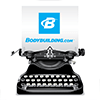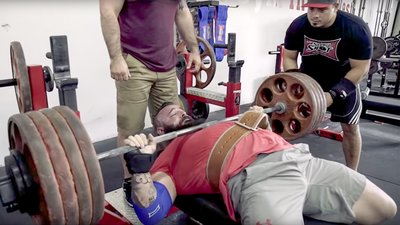Mark Bell is a professional powerlifter, as well as the owner of Super Training Gym in Sacramento, California. His competition achievements include a 1,025-pound squat, a 738-pound deadlift, and an 832-pound bench press. In other words, he's no slouch when it comes to performing jaw-dropping strength feats.
You may never be in Bell's class as a lifter—or even aspire to reach that status—but you can learn valuable lessons from this outspoken strength athlete. For Bell, the ultimate bench press is when form, technique, speed, and power converge to move the maximum amount of weight.
Here are his eight best tips for putting it all together and breaking some PRs of your own.
1. Develop a Pre-Lift Routine
As Bell knows from his years of competition, you need a "constant" when going from one gym to the next for events.
"You want to get a routine down for every piece of this bench-pressing puzzle," he says. "Etch your routine deep in your mind and your body. As the lights, crowds, and equipment change at different competitions, one thing stays the same: your routine."
Correctly positioning your wrists and elbows relative to the bar is a key part of preparing for the lift.
"People bench in different ways, but it's generally a good rule to keep your wrists straight and your elbows into your sides," Bell says. "Keep your wrists and your elbows on the side of the bar where your legs are. Position them above the top side of the bar, and you lose power and leverage."
2. Use the Bar to Assume a Safe Position
When you first lie on the bench, you'll instinctively assume a naturally comfortable position. This many not be the ideal position, or even a safe one. Bell recommends using the bar to lift yourself up off the bench. As you settle back down on the bench, roll your shoulder blades inward and downward toward your hips. Or, as he puts it, "Jam your shoulder blades into your back pockets."
Getting your shoulders in this position will naturally arch your back. This arch provides stability for the lift, but it does something else: It puts your body in a position that makes it harder to overlift. Bell says to put most of the arch in your upper, not lower, back to help protect your spine. Getting your shoulders into this position can also help take stress off an injured shoulder.
Bell notes that you can help another lifter get into proper position by standing up by their head and using your arms to push their shoulders and lats toward their butt. Remind them to keep their elbows in toward their sides so they can recruit as much lat power as possible.
3. Initiate the Lift and Make It Easy on Your Spotter
If you're benching enough weight that you need a spotter to help get the bar off the rack, prepare for the lift in a way that puts you in the right position to bench the weight. This makes the spotter's job easier.
"When taking the bar off the rack, many lifters will push toward the guy who's helping them," says Bell. "If anything, you want to try to pull the bar out of the rack."
Not only does pulling instead of pushing make it easier for the spotter to get the weight to you, it also helps you engage your lats and get your shoulders down and locked into position. Both adjustments are crucial to a good bench.
4. Take the Bar Through a "J' Path
When you take the bar off the rack, you bend your arms to bring the bar to your chest. Bell says to flex your chest as high as you can while keeping your lats tight.
As you come out of the bottom of the bench, flare out your lats to recruit their maximum power. Aim to push up and back toward your neck, following a kind of "J" shape to take advantage of your body's biodynamics.
"Try to keep your wrists straight, and keep your elbows and your wrists on the downhill side of the bar—the side your hips and legs are on," Bell says. "Make sure your elbows are tucked into your sides before you lift. This will bring your lats into play, make you more stable on the bench, and contribute speed and power to the press."
5. Don't Overlift at the Top End
Bell says it's common for lifters to want to explode out of the bottom of the press—and then just keep going. Explosion is great; keep working to develop it. But push your arms too high and your biomechanical advantage vanishes.
"When you notice that you're overlifting like that, correct it by pulling your chest up and away from the bench, bringing your arms down and in to lock in your shoulder blades and flexing your lats to get them engaged'" Bell advises.
6. Experiment With Lifting Shoes
If you've never tried them, Mark suggests giving Olympic lifting shoes a test drive to see if they improve your stability and power. These shoes can be quite a change from normal gym shoes, but with time, they can improve your press.
"Bench presses can put your lower body in awkward positions," Bell warns. "Ideally, keep your feet wide to create a good foundation, positioning them right under your knees or your hamstrings. Keeping your heels on the floor improves your stability and adds more power to your bench."
Getting your body into this position can be hard on your hips and can sometimes even cause cramping. Bell suggests doing hip-loosening exercises before you hit the bench.
Lifters who want to compete should check with the organization sponsoring their competitions. Certain lifting federations, for instance, require bench pressers' heels to maintain steady contact the floor throughout a lift.e says this postion can Getting
7. Improve Your Lockout
Many lifters hit sticking points as they push the bar back up toward the rack. Bell has a few tips for developing the strength you need to push through these points en route to lockout:
Practice the exercise with lower weights using a close grip.
- Practice incline presses, which take much of the arch out of the position and force you to meet the weight head-on. Avoid cheating the lift by using hip thrusts to lift the weight.
- Use a Slingshot, Bell's own invention. This apparatus enables you to build up enough kinetic tension in your chest and lats to help you explode through those last few inches to the top.
- Practice overhead exercises along with exercises that develop your triceps. A good example is the overhead triceps extension using a rope attachment.
8. Practice, Practice, Practice
Perfecting form, technique, speed and power doesn't come naturally to many people. Bell says it can come—with practice and good coaching. While the goal is always to go big, you can do a lot for your bench press by occasionally lifting lighter weight, which may help you focus your form and technique.
"If you normally bench, say, 300 pounds," he says, "try benching with maybe 95-100 pounds and just focus on doing the press correctly. Get your shoulders and lats in the right position. Arch your upper—not lower—back. Keep your feet wide and under your knees or hamstrings. Recruit your lats. Steadily build explosive power and speed."

